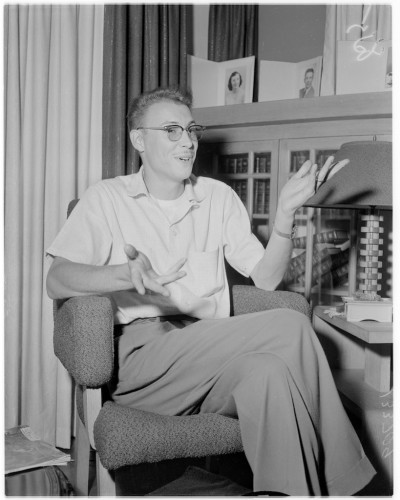Burton Abbott (Burton W. Abbott)

Burton W. Abbott (February 8, 1928 – March 15, 1957) was a University of California at Berkeley accounting student living in Alameda, California, who was tried for the rape and murder of 14-year-old Stephanie Bryan in November 1955. Although the evidence against him was entirely circumstantial, he was convicted and sentenced to death in California’s gas chamber. He was executed in March 1957. As he was being executed, a stay of execution was telephoned to the prison. The outcome of this case raised questions whether the state has the right to execute a person based on circumstantial evidence alone.
Stephanie Bryan was last seen on April 28, 1955, on the way home from school taking her usual shortcut through the parking lot of the Claremont Hotel. A large-scale search failed to find her. Then in July 1955, Georgia Abbott, Burton Abbott’s wife, reported finding personal effects which had belonged to the girl, including a purse and an ID card, in the basement of the home she shared with her husband and his mother, Elsie Abbott. In interviewing the Abbotts, the police learned that Elsie Abbott had found the purse earlier but did not connect it with the case. Police subsequently dug up Stephanie’s glasses, a brassiere, and other evidence. No one in the family could account for how the victim’s personal effects came to be in the basement. Burton Abbott stated he was driving to the family’s cabin 285 miles away near Weaverville, California, in Trinity County, when Stephanie disappeared. Two weeks later the victim’s body was found in a shallow grave a few hundred feet from the cabin. Shortly after, Abbott was charged with her rape and murder.
The trial was one of the most highly publicized in California history. The prosecution hypothesis was that Abbott had attempted to rape the victim and killed her when she resisted. Abbott pleaded not guilty. At the trial all the evidence produced was circumstantial and nothing directly connected Abbott with Stephanie Bryan’s death. The prosecution used emotion to overcome the lack of direct evidence by such strategies as showing the jury the rotten clothes from the victim’s body and waving her brassiere and panties, making implications it could not prove. Abbott explained that in May, the basement of the house had been used as a polling site with many people having access. Although the prosecution charged attempted rape, the pathologist testified that the body was too decomposed to evaluate it for evidence of sexual assault.
Abbott took the stand and testified for four days, testifying in a calm and poised manner. He spoke in a soft voice and was steadfast in his denials of any knowledge of the crime. He said it was all a “monstrous frame-up”. The jury was out seven days before it returned a verdict of guilty of first degree murder. The judge imposed the death sentence. As provided by California law, there was an automatic appeal to the Supreme Court of California. In detailed opinion describing the facts of the case and reciting the evidence that had been presented at trial, the court affirmed the conviction and sentence of death. See People v. Abbott, 47 Cal. 2d 362, 303 P.2d 730 (1956).
Abbott was incarcerated at San Quentin to await execution. His lawyers worked to commute his sentence for over a year. On March 15, 1957, the day of the execution which was scheduled for 11:00 am, his attorney appealed to the United States Court of Appeals, which was denied, and then tried to contact the governor of California, Goodwin J. Knight, but the governor was at sea on a naval ship and out of reach of the telephone. The attorney arranged with a TV station to broadcast a plea to the governor. At 9:02 Governor Knight granted one hour’s stay by telephone. Within six minutes a writ of habeas corpus was presented to the Supreme Court of California but at 10:42 am the petition was denied. The attorney tried again with an appeal to the Federal District Court but the court refused a further postponement at 10:50 am. At 11:12 am Governor Knight was reached again and agreed to another stay. At 11:15 am Abbott was led to the gas chamber and strapped in the chair while the governor was contacting the warden by telephone. The executioner pulled the lever three minutes later and 16 pellets of sodium cyanide dropped into the sulfuric acid as Governor Knight reached the prison warden to stay the execution. The warden told him it was too late, and Abbott died at the age of 29 as the governor hung up the telephone.
Born
- February, 08, 1928
- USA
- Oregon
Died
- March, 15, 1957
- USA
- Quentin State Prison, California
Cause of Death
- Execution by gas chamber


